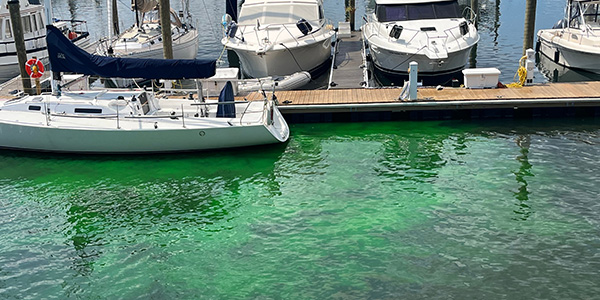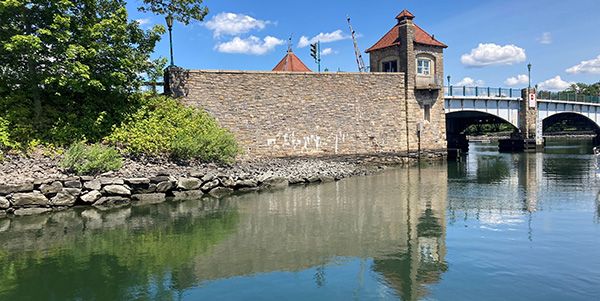
National Water Quality Month began for Peter Linderoth, our director of water quality, with a halting message.
He arrived to our office in Larchmont on the morning of Tuesday, Aug. 1, settled in behind his desk, and checked his email. Near the top of his inbox was an audio file of a voicemail, forwarded by a colleague in our New Haven office, where the call had been received after business hours the day before.
As he pushed “play” to listen, Peter set into motion a 27-hour stretch that turned out to be the best example of how our pollution watchdog program is supposed to work.
“We got a call about leaking sewage underwater near the Glen Island Bridge. It was a short but definitive message with a caller who preferred to remain anonymous,” said Peter, who receives a dozen or so pollution calls every summer, maybe another dozen over the course of the rest of the year.
Of those calls, few materialize into a problem that can be acted upon. The information often requires additional details, and can be challenging for us or municipal staff to find the exact location of the incident that inspired the call. Sometimes, the occurrence is intermittent; even if someone sent to inspect the location were in the right spot, they might be there at the wrong time. It’s also not uncommon for a pollution call to come in with details of an event that isn’t pollution (though these are still important and we encourage all pollution reports.)
“It could be groundwater coming out of a stormwater pipe, which is permitted and usually fine unless it is contaminated. Or they see stormwater coming out of a pipe designed to carry stormwater. Foam on the water is common as well which can often be naturally occurring but could be caused by a pollutant,” said Peter. “We still go and check it out, whether it’s someone from our Water Quality or Soundkeeper team. But a large percentage of the time, we don’t find a pollution source that’s in need of a fix.”
This was one of those cases that would need a fix.

Peter forwarded the information to the Westchester County Department of Health (DOH), Westchester County Department of Environmental Facilities, and the New Rochelle Department of Public Works. Later that afternoon, a few hours after high tide, he went out to the Huguenot Yacht Club, adjacent to the drawbridge leading across New Rochelle Harbor to Glen Island Park, the 105-acre park with a boat ramp and a beautiful beach on Long Island Sound – the second-most widely used park in the county system. One of our community scientists had been at that location earlier in the day, collecting the weekly water quality sample from a spot along the nearby seawall as part of our seasonal bacteria monitoring program in the western Sound. He was asked to do some additional sampling near the reported leak and to inspect the area. That sample yielded low results and nothing regarding a leak was spotted at that time.
Peter spent time on dock closest to the bridge, talking with a Huguenot member and then staff who confirmed they had observed the same thing that had been reported – discharges every few hours on weekdays, maybe every 20-30 minutes on weekends. They showed Peter the area behind a docked sailboat where the incidents were recurring. As he was preparing to leave, Peter spotted the telltale signs of a sewage leak: a cloudy gray plume emanating from underwater, flowing out into the harbor in the direction of Glen Island, followed by floating pieces of toilet paper.
“There was no question what we were looking at,” said Peter.
All along, Peter had been texting with a sanitarian at DOH, who had dispatched someone to monitor the situation in response to a previous report and who was preparing to send out someone else. Once he witnessed the incident himself – three plumes in all, at regular intervals over the span of 45 minutes – Peter called his contact and detailed what he’d seen. He got back to the office and emailed a full writeup, with photos of the pollution and the exact location; he even put a pin on a Google Map to indicate exactly where the county should look.
“We were preparing to come in via boat with our team and do underwater video surveys utilizing cameras that we use for the Unified Water Study to attempt to get more details on the leak origin and type of infrastructure,” said Peter. “We were ready to dig in on this one.”
Turns out, no digging was needed. Not by Peter, anyway.
He received a call on Wednesday morning to meet officials from the county on the bridge. By the time Peter arrived, there were numerous county trucks on site, and the staff was already at work trying to pinpoint the problem.
They conducted a dye test – colored dye was poured into a pump station on Glen Island; if there was a leak in a county sewer line pushing wastewater from the island to sewer lines on the mainland, the next discharge would be a colorful one.
Sure enough, it was. A neon green plume, concentrated at first then dissipating, behaving the same way the gray cloud had the day before.
The county team promptly shut down the pump station, taking the leaking line out of service. A plan was immediately put in motion to run sewage off Glen Island in tanker trucks until the pipe can be dug up, repaired, or replaced – no easy task, considering it was an 8-inch sewer main, buried underground beneath 7 feet of water at low tide, 14+ at high tide.
“The pollution response worked, exactly as it should,” said Peter. “The county responded appropriately, and they promptly and professionally addressed the problem.”
It took 27 hours, from a message online to a broken sewer pipe taken offline. Exactly how pollution watchdog reports are designed to work.
What You Can Do
• If you see something or smell something, say something. Send us an email at pollution@savethesound.org detailing the exact location (a street address and/or GPS coordinates; a screen shot of a map with a pin on the spot is ideal); the time and date of the incident; a thorough description of what you observed; video of the pollution as well as photos (two closeups shots, two wide shots to help us find the right spot when we follow up).
• Register to receive alerts from New York when there is a sewage discharge, as required by the state’s Sewage Protection Right to Know Law, or follow the Twitter feed of the Connecticut Department of Energy and Environment (@CTSewageSpills), where spills are reported to the public.
